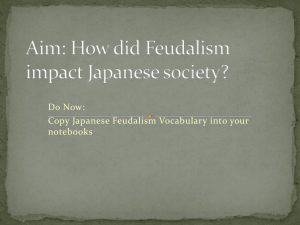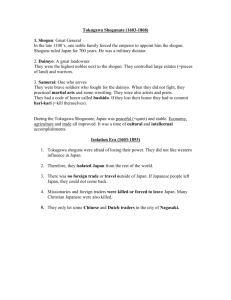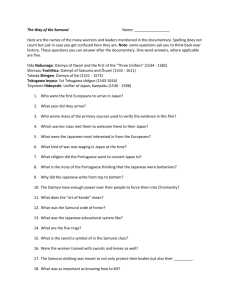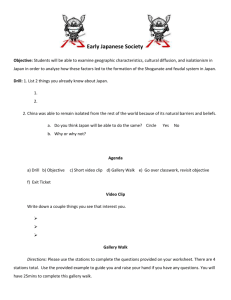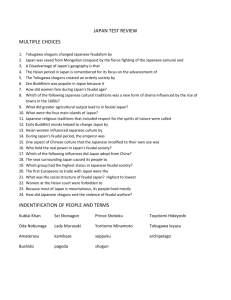Unit 3 Section 1
advertisement
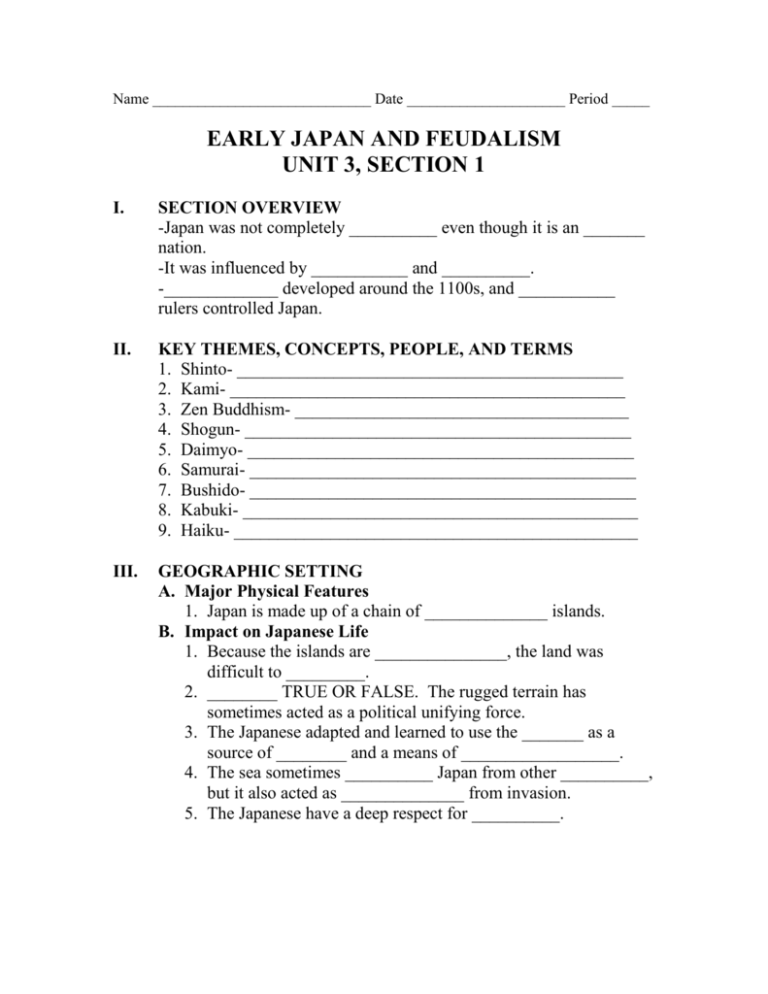
Name _____________________________ Date _____________________ Period _____ EARLY JAPAN AND FEUDALISM UNIT 3, SECTION 1 I. SECTION OVERVIEW -Japan was not completely __________ even though it is an _______ nation. -It was influenced by ___________ and __________. -_____________ developed around the 1100s, and ___________ rulers controlled Japan. II. KEY THEMES, CONCEPTS, PEOPLE, AND TERMS 1. Shinto- ____________________________________________ 2. Kami- _____________________________________________ 3. Zen Buddhism- ______________________________________ 4. Shogun- ____________________________________________ 5. Daimyo- ____________________________________________ 6. Samurai- ____________________________________________ 7. Bushido- ____________________________________________ 8. Kabuki- _____________________________________________ 9. Haiku- ______________________________________________ III. GEOGRAPHIC SETTING A. Major Physical Features 1. Japan is made up of a chain of ______________ islands. B. Impact on Japanese Life 1. Because the islands are _______________, the land was difficult to _________. 2. ________ TRUE OR FALSE. The rugged terrain has sometimes acted as a political unifying force. 3. The Japanese adapted and learned to use the _______ as a source of ________ and a means of __________________. 4. The sea sometimes __________ Japan from other __________, but it also acted as ______________ from invasion. 5. The Japanese have a deep respect for __________. IV. SHINTOISM A. This is the traditional Japanese religion, meaning “____________________________.” B. They worship the _______ or spirits found in all __________ and ____________ things. C. The shared beliefs of ______ helped to __________ all of Japan. D. Developed from Japanese respect for nature. V. DIFFUSION FROM KOREA AND CHINA -Japanese culture is a ________ of its own traditions and ideas borrowed from __________ and ___________. -Often ______ acted as a _________ between ________ and Japan. -Contact came as a result of _________ and ________. A. Chinese Influence on Writing 1. Around 500, the __________ brought the _________ system of writing to the Japanese. 2. By the 800s, the Japanese adapted the Chinese system of writing to suit their own ___________ and ________. B. Buddhism 1. Koreans also brought _____________ from China. 2. During ________ times, _____ Buddhism spread throughout Japan—they value ______, simple living, ______, and beauty. C. Confucianism 1. The principle valued most from Confucianism was its ideas about ________ behavior and _______ order. 2. The ideas of _________ loyalty, honoring __________, and __________ for learning still exist today. D. Customs and Arts 1. Japanese courts adopted such Chinese customs as ____ drinking and the ______ ceremony; Chinese ______ and _______ as well as gardening became popular. ALL OF THIS IS AN EXAMPLE OF _________________________ VI. THE IMPERIAL TRADITION A. A.D. 500 the ________ family established itself as the royal family of Japan. B. The family claimed to be direct descendants of the _____ goddess. VII. FEUDAL JAPAN -1100s—the central authority of the Japanese emperor _________. -While armies battled for power, a ________ system developed. -Feudal society had _________ levels and all members had a defined place. -Feudalism is defined as _________________________________ -Where else in the world did feudalism exist? ________________ A. Landowners and Warriors 1. Under the Japanese feudal system, the ____________ still ruled in name, but powerful warrior _______ actually controlled the country. 2. SHOGUNS—They had the real ________. 3. DAIMYO—as in _________ feudalism the __________ distributed land to the _______ lords, known as __________. This was granted in exchange for a promise to support the _____________ with their armies. 4. SAMURAI—granted land by the ________ in return for loyalty to the daimyo. They live by a strict code of conduct known as ____________. B. Other Classes and Groups 1. PEASANTS AND ARTISANS—__________ farmed the land, and ___________ made weapons for the samurai. In return they were granted ___________ of the samurai. 2. MERCHANTS—Even though they possess most of the ______ than members of the upper classes, they were the ___________ social classes. 3. WOMEN—Early on women became _________ or ran estates. However, over time their status declined. 4. Describe how Japanese feudal system was similar to or different from European feudalism. _____________________ ___________________________________________________ VIII. THE TOKUGAWA SHOGUNATE -1603—brought peace and stability to Japan for 300 years. A. Centralized Feudal Government 1. They created a _______________ feudal government. 2. They stopped the fighting among the powerful ________ by at times forcing them to live at the capital of ______ (Tokyo). B. Economic Prosperity 1. The stability in the government resulted in __________ gains. 2. The use of new seeds, ________, and techniques allowed farmers to grow more food. ____________ grew, _______ increased. 2. The Tokugawa Shoguns became increasingly hostile towards _____________, and barred all western merchants and Japanese travel abroad by 1638. 3. This marked the beginning of Japan’s ______________ period. C. Cultural Advances 1. Kabuki Theater developed; actors wore __________ costumes and acted out stories about __________ or events in __________. 2. In literature, Japanese poets created a __________-influenced form of poetry called _________. MULTIPLE CHOICE QUESTIONS: Page 131-135 1. _______ 2. ______ 3. ______
